The Ten Heroes Most Unworthy Of Justice League Status (Who Joined Anyway)
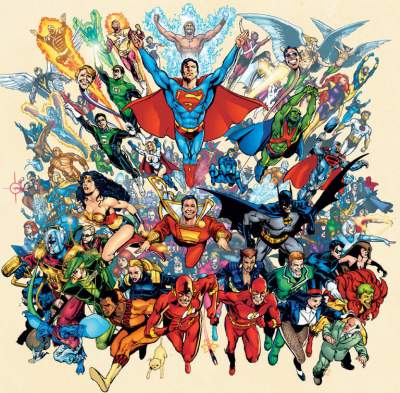 |
The Justice League of America- The most elite super hero team of them all, if only for being home to arguably three of the six biggest super hero icons in the form of Superman, Batman and Wonder Woman. (and if you’re wondering who the other three biggest icons are, that’s easy; it’s Spider-Man, the Hulk and now Iron Man. And that’s just because even your grandma knows who they are. It’s that simple.) Debuting in 1960, the instant success of the JLA led to the Silver Age of comics in earnest, which eventually led to the Fantastic Four and the birth of the Marvel Universe as well.
And for the first twenty three years or so of their existence, the League was the hardest club to get into, like one of those nightclubs in Vegas where everyone looks douchey, but everyone wants to get into anyway, just because they think it makes them look cool to be there, and they can then tell everyone they got in. Unlike their Marvel counterpart team the Avengers, the League rarely let new members in, and if you actually ever left the team, they even made you re-apply (ask Wonder Woman: after she quit they made her take trials to come back. And she’s freakin’ Wonder Woman.) In their first twenty-three years, the original founding seven-member team expanded to nine new members only. Almost all new additions to the team were characters that had been around awhile and had earned some kind of status. Arguably only the Red Tornado was a flat-out nobody when he joined, and he was kind of created to be an android mascot for the team in a way.
This all changed in 1984, when the original Leaguers retired, and let an assortment of all new lame-o characters join the ranks as their replacements. No one had heard of Gypsy, Vibe, Steel and Vixen before, and no one really wanted any of them as members of the once prestigious JLA. (Only Vixen really had a significant hero career afterwards, kind of like Gina Gershon after Showgirls.) Those new characters would be shuffled off pretty damn quickly, but the precedent had been set, and the JLA had opened the doors to their once exclusive team. The proverbial floodgates had been opened, and over the next two decades, the League would welcome fifty-seven new members, many of whom simply did not deserve to be on the team still labeled as the “World’s Greatest Super Heroes” on the cover.The following are perhaps the characters most unworthy of ever being members of comicdom’s premiere super team.
Oh, and before anyone just assumes Vibe is #1…he’s not even on the list. It’s sometimes just too easy to pick on Vibe.
10. The Silver Sorceress & Blue Jay
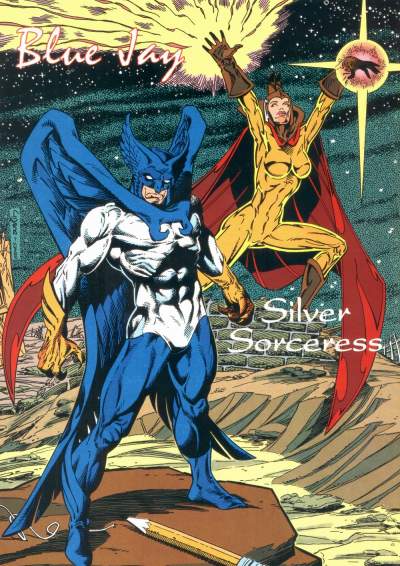 |
Originally created as analogues of Avengers Scarlet Witch and Hank Pym over at Marvel, these two characters first appeared in an issue of Justice League of America way back in 1971. Marvel had just the year before introduced the Squadron Supreme, which were thinly veiled alternate Earth versions of DC’s Justice League heroes. Wanting to show that two could play at that game, in 1971, DC themselves introduced three characters who were alternate versions of members of the Avengers: Silver Sorceress, who strangely seemed to wear brown and gold and not a shred of silver(at least Scarlet Witch wore scarlet); Blue Jay (a combo of the shrinking Ant Man and Hawkman); and Wandjina, an aboriginal God who was essentially a pastiche of Thor. In their first appearance, they were manipulated into fighting the JLA, who they were tricked into thinking were villains after their alternate Earth was destroyed in a nuclear holocaust.
These three characters didn’t appear again for fifteen years, until they showed up in the third issue of the Keith Giffen’s revamped Justice League series, seeking to destroy all nuclear weapons and save our Earth from the fate that destroyed theirs. Wandjina soon died, but Sorceress and Blue Jay joined the League since they have nowhere left to go really, their Earth being nuked and all.
Sadly, these characters never really grew beyond just being poor man’s copies of more popular Marvel characters, and Silver Sorceress was killed off a few years after her return in one of those annual Justice League crossover events, since those things always needed someone to fill the role of cannon fodder/sacrificial lamb. Usually the characters no one cares about are the ones that are the first to go (see: Vibe.) Or just maybe no one was threatened by her helmet that looked like little floppy bunny rabbit ears.
Blue Jay more or less went into limbo soon after, where he stayed for another fifteen or so years, before making one last appearance in James Robinson’s Justice League of America title, just prior to the New 52 relaunch. Blue Jay decided at the end of that story to fly off into the Multiverse, searching for a world that might appreciate him more than the main DCU Earth did. Good idea Blue, nobody really cared about you around those parts anyway.
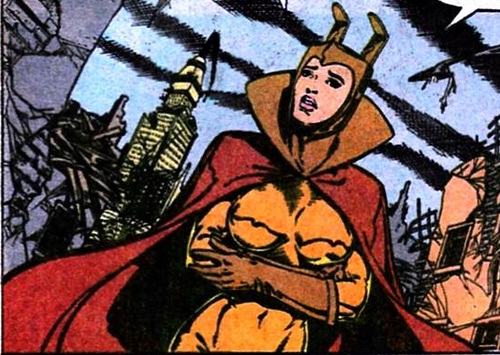 |
| Shouldn’t she be called the gold and brown Sorceress? And girl…them floppy bunny ears aren’t working for ya. |
9.General Glory
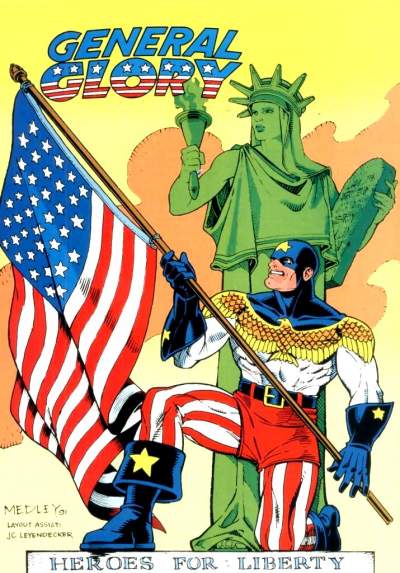 |
Apparently having not learned anything from the previous entries Silver Sorceress and Blue Jay, DC once again decided to let another parody of a Marvel hero into the League’s ranks; this time the character being lampooned was none other than Captain America. General Glory originally appeared in a rather great five-issue run of the Keith Giffen era sitcom like Justice League International during the early ’90s, and as a comedy gimmick, he worked pretty damn well. Given a silly Golden Age style origin, World War II soldier Joseph Jones was granted powers by Lady Liberty herself, and became General Glory. In the story that introduces him, Green Lantern Guy Gardner finally meets his childhood idol General Glory, there are some Nazi robots to fight, and general hilarity ensues.
The problem is that after this storyline, DC decided to make him a serious member of the team, and that’s really when the whole thing just falls apart. Then, instead of a clever spoof of Captain America, all you’re left with is a lame knock off of Captain America instead, and it’s not quite the same thing anymore. The character was eventually killed off, and DC, never one for learning their lessons, replaced him with Agent Liberty, yet another Cap knock-off that no one really liked, and who also got killed off rather unceremoniously.
8.Bloodwynd
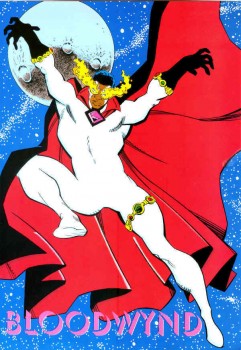 |
The ’90s was the era were all the major publishers decided that super hero names just needed to sound “cool” or “badass” to appeal to teenage boys, and not be descriptive of the character’s powers or personality in any real way. Every new character suddenly sounded like crappy death metal bands, with names like “Reignfire” or “Death’s Head.” And then there was the League’s own attempt at “coolness,” the African-American sorcerer Bloodwynd. Although in all seriousness, just what is a ‘wnyd” anyway? Why not just spell it Bloodwind, since that’s how it’s pronounced? I wonder how many kids pronounced it Blood-whined instead.
Another character who was created to presumably add some kind of racial diversity to the League, yet never really came across as anything interesting or non derivative of other, better characters, Bloodwynd felt like kind of a DC attempt at Dr. Strange, but with far more questionable origins. Created by writer/artist Dan Jurgens, Bloodwynd first appeared in 1992, and was the descendant of a group of African-American slaves owned by a cruel slave owner by the name of Jacob Whitney. These slaves, at some point in the pre-Civil War past, performed an ancient African ritual to create a mystical Blood Gem, with which they then killed their master.
The Gem was then passed down among the slaves’ descendants, and bestowed magical powers on the person who wore it. However, it also contained a microscopic world, where Jacob Whitney’s spirit had become incarnate as the demon Rott. Over the years Rott grew stronger, as the Gem absorbed the darker side of each wearer’s soul. If you’ve tuned out and stopped caring while reading this convoluted mess of an origin story, then imagine what the readership felt like back in the day. Super hero origin stories should always be able to be explained away in about two sentences,and this whole origin story is already too complicated for its own good. Aside from all that, tying Bloodwynd’s origin to the tragedy of slavery also make the taste level questionable. Not that you can’t use a tragic event from real history for fictional purposes (see also: Magneto) but if you’re gonna do it, do it for a good reason and do it tastefully.
Even worse than all that, when Bloodwynd first appeared, he wasn’t even Bloodwynd, he was the Martian Manhunter in disguise as Bloodwynd, while the real one was still trapped inside of the gem. The “real” Bloodwynd was freed and joined the League, but at that point nobody gave a crap anymore. I do think Bloodwynd had kind of a cool costume actually, I’ll give him that (even though he has that weird gold chain around his leg. What’s up with that design detail, Mr. Jurgens?) And his special abilities were kind of interesting (he could summon the powers of the dead for magical purposes) but his personality was just stock. I’m not sure he was ever even given a civilian name. And without a personality to latch on to, readers just didn’t care.
7.Triumph
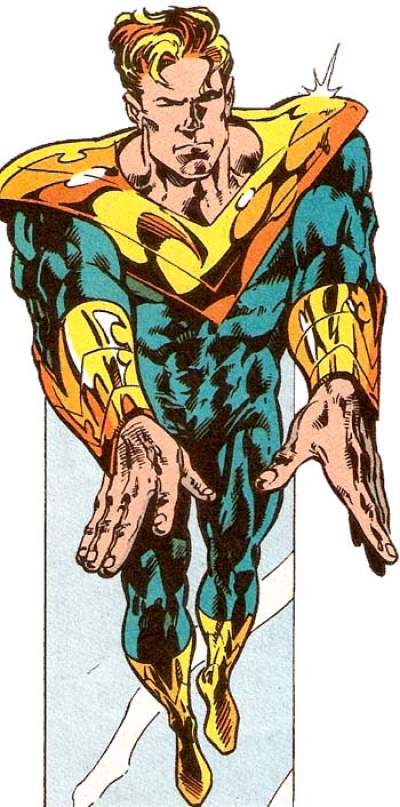 |
No, not the Insult Comic Dog…that Triumph is way cooler. This Triumph was really William MacIntyre, created back in 1994 during DC’s Zero Hour crossover mini series. A supposed original founding member of the Justice League who, after their first adventure together, was sent to limbo, and his entire existence and past forgotten by the world at large. Right off the bat, fans hated the character, because there is almost nothing fanboys hate more than being told a new character they’ve never heard of before has really been there all along, they just didn’t know it. (Marvel fans had a similar reaction to The Sentry, and for almost the exact same reasons.) It’s like the character is being told they’re important to the audience, without ever having earned it.
Fans bristled at the notion that this new guy had to now be accepted on the level of Superman, Batman, Wonder Woman and the others, when everyone knew he had just been made up like the week before. Add to that, neither his powers (he could control the electromagnetic spectrum) or his look (standard blonde white dude in a crappy costume) came across as interesting or cool, making his newly retconned status as a JLA founder seem even more insulting.
Eventually, Triumph became a member of the Justice League Task Force, before fading away, mostly because, again, no one really liked him. By the late ’90s, superstar writer Grant Morrison had reinvigorated the JLA franchise with his version of the team, which featured a return of the “Big 7” concept. He reimagined Triumph as a bitter recluse, selling off JLA memorabilia just to pay the rent (the super hero version of blow jobs in an alley for cash.) He tried to make the JLA pay for forgetting all about him, much as the DCU readership had, one of Morrison’s more meta-moments on the title. In Morrison’s story, Triumph becomes a villain, echoing how much the fans just plain hated the poor guy.
6.Faith
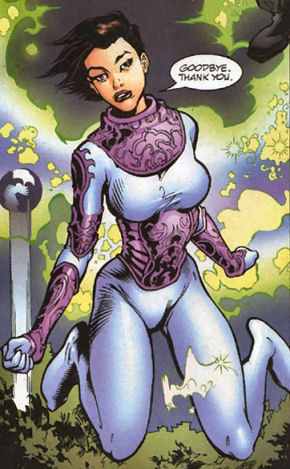 |
Proving that not all unworthy Leaguers came from the late ’80s and early ’90s, Faith was a character who joined during writer Joe Kelley’s tenure writing the team, circa the early 2000’s. Faith (real name unknown) boasted powers that were psychokinetic and telepathic in nature, with an ability to “create an aura of trust and confidence within the people around her, allowing a group to work together easily.” Which is quite possibly the lamest power ever. Maybe her code name should have been “Alcohol” instead of Faith.
Aside from the social lubricant power, she had also started to show some other useful mental powers, maybe in an effort to make her DC’s version of Jean Grey. She was originally meant to be a mysterious character, whose true name and backstory would slowly be revealed over time. Sadly, it was a mystery no one was clamoring for an answer to, and once Joe Kelley left the title, so did Faith, mysteries unsolved. She briefly joined one of the more recent incarnations of the Doom Patrol, before disappearing off to limbo. Wherever she may be, I hope she’s inspiring confidence in as many people as she can.
5.L-Ron
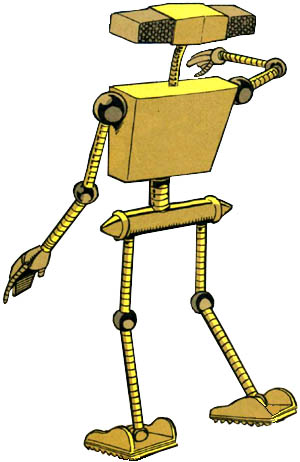 |
Once upon a time, the League was so lax into who they allowed to join their once esteemed ranks, they even allowed a little robot named after the founder of the Church of Scientology to join the team. Originally, L-Ron was just a loyal C-3PO like servant of intergalactic bad guy Manga Khan, just snarkier and even more sarcastic. At some point he ended up working for the League itself, when Manga Khan traded him off. When he was just a robot version of Batman’s Alfred the butler or the Avengers’ Jarvis, he was actually kind of a fun addition to the League, during a time when comedy was more important than super heroics.
Not too long after he was made a member of the JLA supporting cast, some brilliant editor at DC decided he should be an actual member of the team instead, so they placed his mind in the comatose body once inhabited by former League villain Despero, a hulking, purple alien tyrant. What this really just meant that they ruined two perfectly good characters by morphing them into one giant sillier one. At some point, under circumstances that were never really made clear, L-Ron once again returned to his little robot body, and began dating another robot named (wait for it……) J-Lo. *sigh* Let’s just move on, shall we?
#4.Black Condor
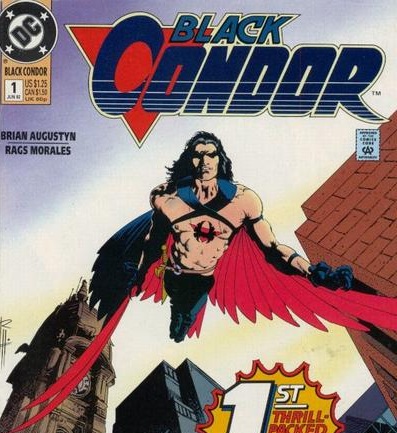 |
Yet another unoriginal, unappealing character from the early ’90s who somehow got a spot on the world’s most high profile super hero team. The original Black Condor was created in 1940, and had the power of flight. And that’s it. In a medium where just about everyone and their Aunt Rose could fly, that’s not terribly exciting. But here’s the awesome part – he could fly because as an infant, his parents were killed while on a trip in Mongolia, and he was then raised by a group of super intelligent condors who then taught him how to fly. Remember that the next time you laugh at “bitten by a radioactive spider.”
But it wasn’t that version of Black Condor who joined the JLA; instead it was the original Black Condor’s successor, Ryan Kendall. Although not raised by birds, Kendall was granted powers by “The Society of the Golden Wing”, a secret cabal dedicated to making a man fly (a rather odd mission statement for an evil secret organization, if you ask me.) This version of Black Condor debuted in his own short lived series back in 1992. I’m not sure what DC was thinking here; they already had a super hero whose only real power was having wings and flying, and Hawkman at least had a bad ass helmet/mask and a cool medieval mace. If they struggled to get Hawkman to sell comics, what made them think Black Condor was gonna be the next big thing?
In any case, probably in an attempt to boost sales for his dying book, Black Condor was placed in the JLA. It didn’t work; his book was canned anyway, and just like that, Black Condor was booted off the League. He made occasional appearances throughout the DCU over the years before finally being killed off like a red-shirt on Star Trek in the DC mini-series Infinite Crisis.
I should add there was one more character at DC that held the name Black Condor, if only briefly. In Superman #349, Superman’s foe Mr. Mxyzptlk uses his powers to give everyone on Earth a sex change. Lois Lane became Louis Lane, Wonder Woman became Wonder Warrior, etc. And Black Canary became the male Black Condor. What was awesome about this Black Condor is that he essentially wore Black Canary’s costume, minus the fishnets. Just a leather jacket, booty shorts, and pirate boots. Black Condor was ready to be a go-go boy in some gay nightclub somewhere, and I bet he would have been ten times more interesting than the version that actually joined the League.
 |
#3.Maxima
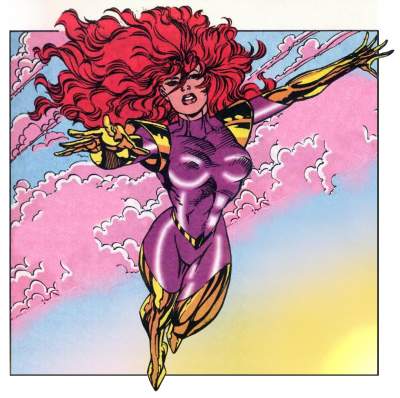 |
Maxima was originally introduced as a villainess in the pages of Action Comics back in the late eighties. Hailing from the planet Almerac, and boasting a set of formidable super powers herself, Queen Maxima came to Earth looking for a suitable mate. She chose Superman, of course (who wouldn’t?) , but he rejected her, being faithful to Lois and all, leading to lots of punching and kicking. Eventually, Maxima was exiled from her homeworld and stranded on Earth. In yet another stupid attempt at getting Superman to want to do her, she joined the Justice League. Because at this point, they’d obviously take just about anyone, even if your entire super heroic resume was being a cheesy Superman villain.
Maxima joined the team at around the time that Superman died, and eventually joined the horribly named spin-off group Extreme Justice, where she decided to turn her romantic obsessions towards Captain Atom instead of Superman. It is kind of sad that a female character with as much power as Maxima was reduced to being all about who she wanted to screw and be her baby daddy.The Extreme Justice team was short lived, and after the book’s cancellation, Maxima kind of floated around the DCU, before being mercifully killed off in the Our Worlds at War crossover in 2001.
Despite coming with a pretty solid array of super powers (speed, flight, strength, power beams, telekinesis, the whole enchilada) Maxima never came across as really being all that powerful, and her character never grew much beyond her paper-thin original portrayal as a spoiled intergalactic queen, just out lookin’ for a man. She was essentially created to just be a campy villain, and trying to make her anything else was kind of against the whole point of the character. The Superman animated series from Bruce Timm probably did the most successful version of the character to date, and wisely chose to embrace the original campy aspects of her character’s introduction. Needless to say, powers or not, this reformed villainess was never League material.
2.Aztek
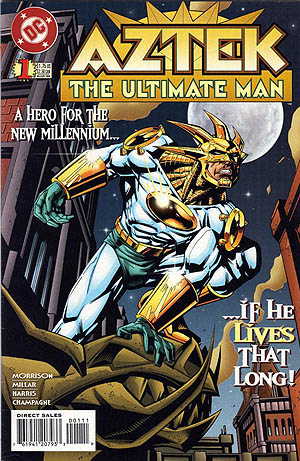 |
Aztek actually isn’t that lame of a character – he could have been a contender. Created by Grant Morrison and Mark Millar, Aztek came into the world with some serious comic-book pedigree. Still, despite having his own short-lived series that ran at the same time as Morrison’s JLA, I can’t help but think that Aztek was created with the only intention to be JLA cannon fodder in Morrison’s final storyline in the JLA book. And if you were created just to be killed off, then in my mind you’re not really League material.
Originally named Uno, the man later to be called Aztek, The Ultimate Man is raised from childhood by a secret organization named the Q Society to be the champion of the Aztec god Quetzalcoatl to battle their enemy, the Aztec god Tezcatlipoca. He is given a magical suit of armor that grants him an assortment of super powers,which only added to his already perfect human mental and physical abilities. Eventually, he comes to America and assumes the identity of a recently deceased doctor named Curt Falconer.I have to admit, Curt Falconer is a pretty badass civilian name.
Aztek later joins the JLA, but quits when he discovers that one of the mysterious benefactors of the Q Society is none other than Lex Luthor. He is later blinded helping the League save the Earth in a battle against the planet-destroying machine Mageddon. Aztek ultimately sacrifices himself to allow Superman the chance to destroy Mageddon during Grant Morrison’s final story arc on JLA, which I believe was the whole reason he was created anyway. Aztek did appear once on the Justice League Unlimited cartoon, probably the last place we’ll ever see him again, unless the New 52 decides to dig up his corpse for yet another character reboot.
1.Mystek
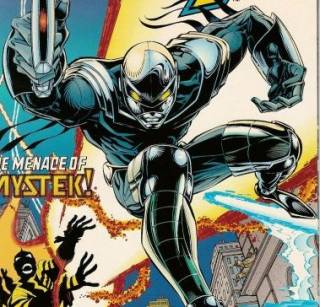 |
The lowest point in the League’s acceptance of characters who hadn’t earned “World’s Greatest Hero” status simply had to be mid ’90s hero Mystek. This is how low rent a hero Mystek was; she was first introduced as a villain in an issue of The Ray, himself a pretty third string super hero (let’s be honest). Mystek was a Korean woman named Seong who posed as a man, and her costume was in fact sculpted to hide the fact that she was a woman. Mystek had your general flight and energy manipulation powers, which it seemed every super hero had.
Mystek was approached by the Martian Manhunter to join the Justice League Task Force, and only lasted a few issues before being killed off in quite possibly the most embarrassing way any Leaguer has ever bitten the big one. Not too long after joining the League, the team was on a mission in outer space. The cramped spaceship escape pod proved to be too much for the (apparently) extremely claustrophobic Mystek, and, after over two days of travel, she panicked, blasting her way into open space, where of course she suffocated and died. I can’t even imagine Vibe ever doing that.
Even funnier is the behind the scenes reason why Mystek came to such an inglorious end; she was originally created by writer Christopher Priest to be a creator-owned character, set to star in her own miniseries. Initially, Priest was told to put her in Justice League Task Force to introduce the character to a larger audience and create name recognition. When the plans for the miniseries fell through and DC decided not to do it, Priest chose instead to simply kill the character off completely. Less than a year after this happened, DC chose to cancel all their various Justice League spin-off series, and relaunch the book under Grant Morrison simply as JLA, with the big seven icons back after a far too long absence. Mystek’s inclusion into the once hallowed halls of justice brought an end to the era when the League would just let any old nobody into the once select club.

